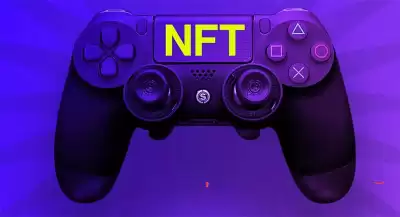How to find a large and profitable project in the field of crypto?
30-12-2022, 17:33
Recently, Play-to-Earn games — "play to earn", or P2E, have greatly influenced the crypto-gaming industry. According to NonFungible, in July 2021, sales in the NFT market reached a record $2.5 billion, which was a significant jump from the time of $13.7 million in the first half of 2020.

Moreover, since May 2021, the number of wallets connected to games has increased dramatically to the level of 750,000 active users. What are the reasons for such impressive figures? One of them is the growing demand for games in which you can earn money.
This article will answer the question "how does the Play-to-Earn crypto-gaming model differ from the traditional game and tell about some large investors investing in this popular niche.
The jump in popularity of cryptocurrency games
What is a game where you can earn money?
What is the success of Play-to-Earn?
Cryptocurrency games and in-game items
Play-to-Earn Cryptocurrency Games vs Traditional Games
Axie Infinity
Play-to-Earn Games on the Blockchain
Metaverse and Play-to-Earn
Venture Capitalists' Interest in Play-to-Earn
Even more P2E games
The Future in Crypto Games
The jump in popularity of cryptocurrency games
Blockchain is really a revolutionary technology. Here, users can safely make transactions with each other without the participation of a company, a bank issuing credit cards, or another third party. This technology has the potential to change any industry, and the gaming sector is no exception.
Play-to-Earn Games
Thanks to such blockchain innovations, crypto games encourage game developers and their players to move from Web2 to a new and improved decentralized Web3 model. In Web3, players themselves earn income from the games they play.
What is a game where you can earn money?
Blockchain-based games that give players the opportunity to monetize their playing time are called games in which you can earn money, or simply "Play-to-Earn". Previously, only professional players were paid; however, thanks to the growing P2E movement, any gamer can receive money for their playing time.
What is the success of Play-to-Earn?
The success of P2E is as follows:
Evolution of financial mechanisms in crypto-gaming.
The interest of users in receiving payment for the game.
Second-level scaling solutions.
Of these three factors that played a role in the popularity of Play-to-Earn, the third one stands out in particular. Crypto-gaming platforms, which were the first to implement second-level solutions, saved their players from exorbitant transaction fees.
The Play-to-Earn model offers players the earnings of any of the two assets, and this is:
In-game currency
One of the ways to receive payment is in—game currency. Since most crypto-gaming platforms have native cryptocurrencies, native tokens are good for buying in-game NFTs. Other use cases include managing, staking, or exchanging tokens for fiat on a centralized exchange.
Earnings in the form of NFT
Players playing on the blockchain can also earn by trading the received NFT on certain trading platforms, such as Raible or OpenSea.
Cryptocurrency games and in-game items
One of the driving forces behind the success of crypto games is "in-game items". According to DappRadar, in the third quarter of 2021, they accounted for $2.3 billion in trading volume, which is 22% of the total.
Play-to-Earn games rating
NFT is a token representing a digital asset. A wallet containing an NFT represents ownership and can transfer it to another wallet. Blockchain not only registers property rights, but is also decentralized and immutable. This means that no third party can interfere and take away the owner's rights from the owner of a certain NFT.
Play-to-Earn Cryptocurrency Games vs Traditional Games
The difference between crypto games and traditional games lies in NFT. NFTs can include things like in-game items and collectibles. NFTs can also represent the virtual earth that is in the game.
Players in traditional games can also buy in-game items. But do they own them? Not quite. Players have a license for a digital copy stored on a central server. If the company goes bankrupt, and the server fails or disappears, the in-game item and the certificate of ownership will disappear along with this very server.
On the other hand, NFTs representing in-game items "live" in an unbreakable blockchain. Gamers get full control over their in-game items. They can transfer their assets to various NFT exchanges, because transactions are not limited to the original market of the game. So, in-game items have become tradable investments, and this whole concept is destroying the traditional gaming infrastructure.
Now that you know the main differences between traditional and crypto games, it's time to explore the P2E model itself. Next, we will look at some examples of similar games.
Axie Infinity
Axie Infinity is one of the most popular Play-to-Earn projects. In August of this year, the number of daily active users reached a staggering one million people. "Axies" are the main characters of the game, representing NFT, which players, in turn, can buy or sell.
Axie Infinity
Axie Infinity's Success with Play-to-Earn
One of the success factors was, paradoxically, Covid-19, when people only had to earn from home. Another similar project was "Ronin", which is spread out in the Ethereum chain.
The Sky Mavis team created Ronin in order to save users from high transaction fees. Ronin helped Axie Infinity soar to sky-high heights, and become the best-selling NFT collection in history. The trading volume of Axie NFT is already approaching $3 billion.
Play-to-Earn Requirements
On Axie, players can earn up to 75 SLP tokens daily. To do this, they must complete daily tasks and play mini-games. A regular Axie Infinity player can earn about $2,700 a year. This may seem like a small income, but it can greatly affect the economy of countries with only a developing economy (such as the Philippines or Vietnam).
Thus, the democratization of gaming time and income is beneficial, first of all, of course, to the gaming industry, as well as to players and countries with developing economies. However, the P2E revolution has gone beyond Axie Infinity, and other new offerings are currently in development.
Play-to-Earn Games on the Blockchain
Splinterlands is a P2E collectible card game on the Hive blockchain. Players compete by developing strategies for their NFT cards in PvP battles. By completing quests, they earn an in-game currency called "Dark Energy Crystals" (DEC).
In September, the number of unique active Splinterlands wallets increased to 245,000 per day. This is a colossal increase of 3,260% compared to the June figures. The surge in growth resulted in more than 58 million transactions, bringing the game's market capitalization to over $200 million.
Play-to-Earn on the Blockchain
Crypto games Alien Worlds and Upland have also increased their player base in 2021. Upland allows players to own virtual lands that mimic real cities such as New York and San Francisco. This is one of the most popular blockchain games in 2021.
Alien Worlds, a space battle game, has an average of over 500,000 active wallets per month. In just one week Splinterlands and Alien Worlds together attracted more than a million users.
Metaverse and Play-to-Earn
In Neil Stevenson's science fiction novel Avalanche, the metaverse was first described, which was then popularized in the novel "The First Player to Get Ready" by Ernest Klein. The metaverse is a place in virtual reality where people can play, trade, communicate and perform all sorts of other actions.
Blockchain-based virtual worlds collected more than $56 million in trading volume in the third quarter. The Sandbox, a game similar to Minecraft, allows players to build entire cities by monetizing them with the in-game currency "SAND". The big players in The Sandbox are, for example, the notorious Atari and Snoop Dogg.
Also popular games in the metaverse are Somnium Space, CryptoVoxels, Treeverse and Ember Sword. Interestingly, the decentralized metaverse is being transformed into a virtual reality ecosystem based on P2E games.
Players are already beginning to understand the full potential of blockchain games. Especially now, when all the media attention is focused on the metaverse.
Venture Capitalists' Interest in Play-to-Earn
Some forecasts for the video game industry suggest that by 2023 it will exceed the value of $200 billion. World of Warcraft, by the way, has brought in more than $ 10 billion in revenue over the past ten years, and virtual worlds based on blockchain, taking into account their novelty, do not lag behind these indicators.
At the same time, the P2E movement is gaining momentum, which has already attracted several large investors. Venture capital firm Andreessen Horowitz recently invested $150 million in Sky Mavis, the creators of Axie Infinity.
Another example is Sorare, a P2E fantasy football game startup that received $680 million in a Series B round from SoftBank's Vision Fund 2.
Dapper Labs, the firm behind the NBA Top Shot, and CryptoKitties have attracted more than $600 million in investment from venture capitalists, which, again, includes Andreessen Horowitz.
Animoca Brands was invested in Star Atlas . This is a P2E game under development that will run on Solana. Thanks to its tokenomics and a variety of gaming NFTs, Star Atlas aims to build a galactic economy that includes politics, mining conspiracies and, more importantly, battles. Along with Star Atlas, Animoca's portfolio of investments includes Arc8, Revv Racing and The Sandbox.
Even more P2E games
Illuvium is another Play—to-Earn game that will run on the Immutable X blockchain. Immutable X is a second-level solution using zero-knowledge accumulative packages (zk—Rollups) as a consensus mechanism.
In Illuvium, players can catch and breed so—called "illuvials" - game creatures. In this respect, it is similar to "Pokemon".
Gala Games is a startup seeking to create a decentralized ecosystem based on games in which you need to earn money. They have already launched "Town Star". This is a game from the category of "farms", in which players receive their own GALA token.
The Future in Crypto Games
Play-to-Earn expands the possibilities of players by providing them with earnings that directly depend on their playing time. Approximately 2.5 billion gamers around the world, combined with the innovative blockchain technology and the disruptive nature of P2E games, can affect the global economy.
Venture investors are investing millions of dollars, and this influx of capital will help pave the way for a new generation of P2E games. So we can say that the future of Play-to-Earn crypto games is very rosy and positive, however, you need to do a lot of personal research before you dive into earning money in the world of Play-to-Earn games!
30-12-2022, 17:33
30-12-2022, 17:59
13-02-2024, 10:16


1 comments
Information
Users of Visitor are not allowed to comment this publication.